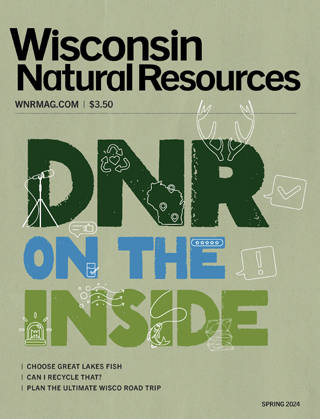A happy tune
KIRTLAND'S WARBLER PLAYBACK PROJECT SHOWS PROMISE AS KEY CONSERVATION TOOL
Story by Lisa Gaumnitz and photos by Nick Anich
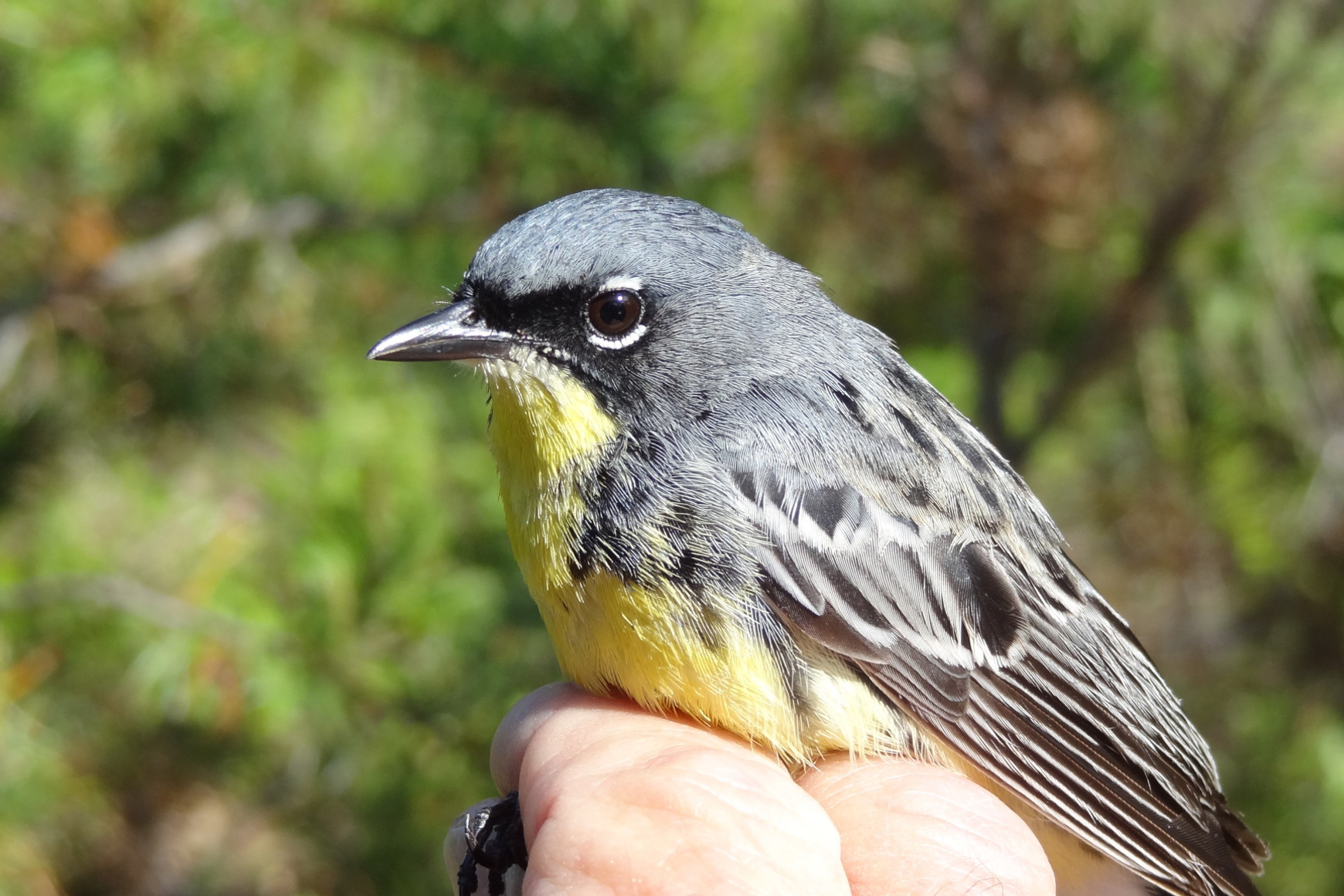 The Kirtland's warbler measures about 5½ inches long and weighs under a half ounce.
The Kirtland's warbler measures about 5½ inches long and weighs under a half ounce.Call it eHarmony for birds.
Every day, three times a day for several hours, a Kirtland's warbler belts out a love song at the top of its lungs in Bayfield County Forest. Its dawn chorus is not live but a recording that Nick Anich and collaborators are using to lure Wisconsin's rarest songbird species – a tiny endangered bird with very particular habitat needs – to the forest.
"We're announcing, the party's here," says Anich, a conservation biologist with DNR's Natural Heritage Conservation Program. "The presence of other individuals at the site during breeding season is one cue, or way, the birds assess the habitat quality of a breeding site."
Anich wants to attract birds to the site and increase the odds they stick around long enough to have a chance encounter that will lead to something more: a male and female pairing off and nesting.
For three years he played matchmaker to Kirtland's warblers, and it has paid off. Starting slowly but building steam, the audio playback has helped males and females find each other and successfully reproduce at sites more than 140 miles from the main breeding area in Wisconsin and more than 300 miles from the species' core population in Lower Michigan.
This method has helped build Wisconsin's population of the songbird and provide an important backstop to the core population. It's helping shift the bird's range northward at a propitious time. And it's garnering international attention as a promising conservation approach in an era of accelerating species and habitat loss.
Rather than trying to create and manage habitat for a given endangered species where it's currently or has historically been found, the playback method can attract species to areas where the ownership, land use and habitat management are more conducive to their recovery.
"I know when Nick and Mike first proposed it, I thought, 'Wow. That is a great idea,'" says Carol I. Bocetti of California University of Pennsylvania, the longtime leader of the national Kirtland's Warbler Recovery Team. "It really does look promising. This is going to be a pretty cool tool."
Getting the party started
The Kirtland's warbler playback project hatched at a bird conference in Chicago in 2013 when Anich, part of a Wisconsin team working on Kirtland's warblers, met Michael Ward, an ornithologist for the Illinois Natural History Survey. Anich was well aware of Ward's pioneering work using audio playback to help achieve conservation goals. The two started talking and figured there was a natural collaboration.
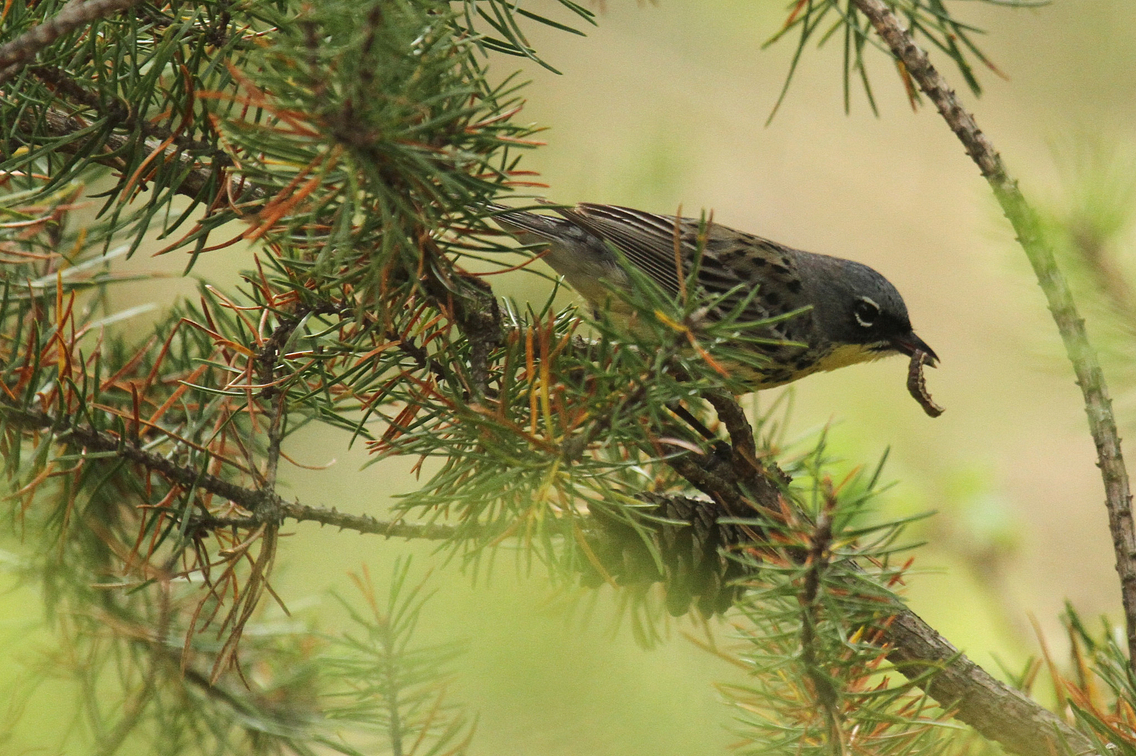 Playback project was intended to lure Kirtland's warblers to habitat that provided food and nesting conditions they prefer.
Playback project was intended to lure Kirtland's warblers to habitat that provided food and nesting conditions they prefer.Ward had used audio playback to help lure the endangered black-capped vireo away from parts of a U.S. Army installation in Texas used for blowing up munitions. He used the technique in Illinois to help endangered terns find an artificial nesting platform, and he had a "ribbeting" success using audio playback with frogs. Ward continues that line of research at Fort McCoy and a Louisiana army installation, hoping to develop ways to move amphibians away from artillery testing grounds to newly created wetlands.
Growing up in Illinois, Ward's observations of territorial birds oddly clustered together sparked his interest, and later his ideas, for how to aid endangered species.
"Logically you might think if birds were territorial they'd be away from one another, but they were in the same area," says Ward, also an associate natural resources and environmental sciences professor at the University of Illinois at Urbana-Champaign.
Turns out the birds were picking up on social cues that the habitat was good, similar to how humans pass by an empty restaurant and intuitively think it's not good, while surmising the opposite is true if the parking lot is full.
Scientists call it conspecific attraction – "conspecific" meaning "of the same species," and "attraction" meaning using cues relevant to that species to get them to a location.
"It's trying to get the birds to show up at the same place at the same time in good habitat," Ward says. "It's positive reinforcement that this is a good place to build their nest."
Scientists are still discovering all the different cues birds use to find habitat. Vocalization is the easiest cue to mimic and use.
Most research using audio playback, however, involved short-distance romance, not the avian equivalent of flying a marathon to find a needle in a haystack.
At the time Ward and Anich launched their collaboration in 2014, Wisconsin had documented only about 30 Kirtland's warblers, and the main nesting area was in Adams County in central Wisconsin. But Anich and Ward thought trying to lure the birds to promising habitat in northern Wisconsin was worth a try.
Kirtland's warblers are very good as a species at roaming great distances to find their nesting spot, and the birds had sporadically been seen in northern Wisconsin since 1978. Giving them a social cue, i.e. a vocalization, just might attract migratory Kirtland's warblers to hang out in the right place at the right time.
Perfect home away from home
For a Kirtland's warbler, the right place at breeding time is an open landscape with young stands of jack pine on sandy soil. The sweet spot features trees 8 to 15 years old, possibly because they have live lower branches that can hide the open-cup nests the warblers build on the ground.
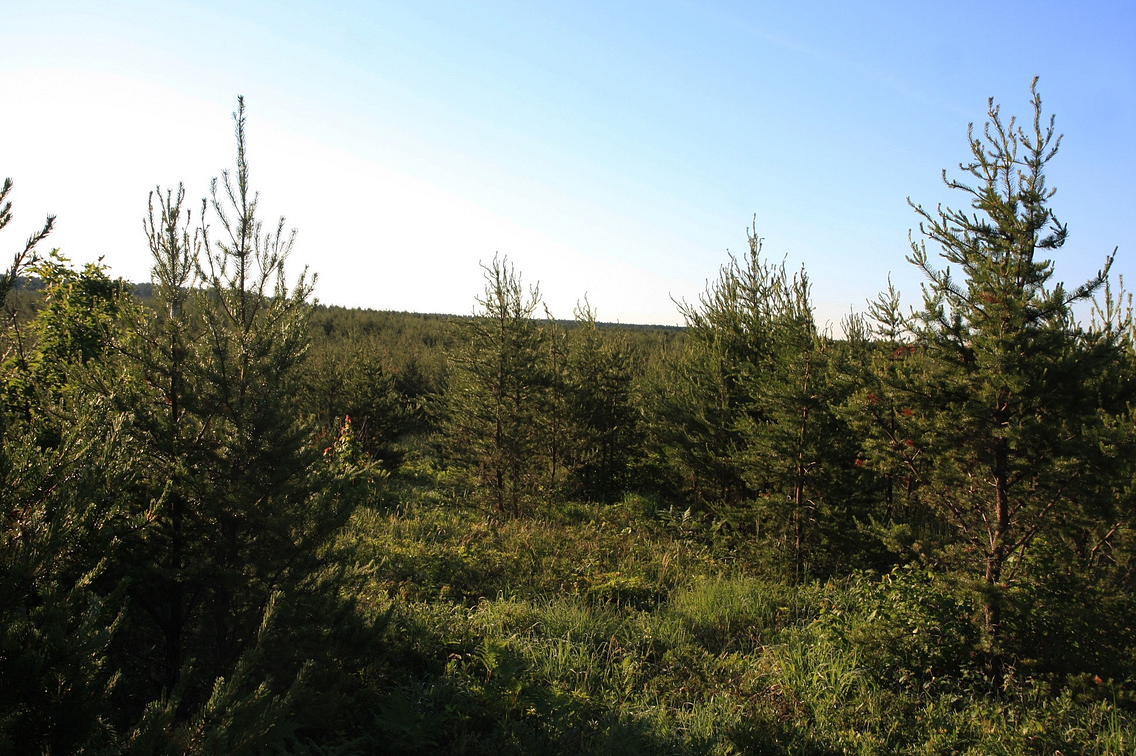 Open terrain with sandy soil and stands of young jack pine is vital habitat for the Kirtland's warbler.
Open terrain with sandy soil and stands of young jack pine is vital habitat for the Kirtland's warbler.Historically, this habitat, known as pine barrens, covered a good swath of Wisconsin and had been maintained by fires, but logging in the 19th century and fire suppression in the 20th century, along with other land-use changes, significantly reduced such habitat. Now, pine barrens cover less than 1 percent of the area of Wisconsin present at statehood, and they are globally rare, too.
Coincidentally, about the time singing male Kirtland's warblers started showing up in Adams County in 2007, Bayfield County foresters were sitting down with DNR biologists to talk about managing some of their 170,000-plus acres to preserve pine barren habitats for wildlife and for timber harvest.
Jason Bodine, Bayfield County Administrator of Forests and Parks, says Bayfield County officials had seen the benefits to wildlife like sharp-tailed grouse of grassy areas maintained between forest stands to serve as natural firebreaks. They wanted to maintain those benefits and bring in timber revenue for county residents.
Their resulting Barnes Barrens Management Plan seeks to optimize wildlife habitat and timber value on what will eventually be 11,500 acres within the forest. It wasn't created with the Kirtland's warbler in mind, but the plan was flexible enough to be updated to accommodate management specific to the songbird, Bodine says.
Now under the plan, a 1,000-acre grassy core is permanently left open and managed with prescribed fire to keep pine and brush from encroaching. Four zones of 2,500 acres each ring the grassy core. Each zone is to be harvested over 12 years and reseeded whenever possible with jack pine. The cycle will be repeated roughly every 48 years to ensure a variety of age classes and open barrens on the landscape, Bodine says.
"There are a lot of creative things you can do to maximize a lot of the different benefits," Bodine says. "Here's a way in which we can cover both bases at the same time."
Let the courtship begin
Anich and Ward started their playback research in 2014 with funding from the Bayfield County Forest, the U.S. Army Construction Engineering Research Laboratory and the Natural Resources Foundation of Wisconsin. They selected research sites in Bayfield, Marinette and Vilas county forests as well as the Chequamegon-Nicolet National Forest in Bayfield County. Singing Kirtland's males had previously been documented on these sites, which were all on public lands where management for jack pine was feasible.
 Battery-powered call boxes send out Kirtland's warbler call to attract birds to northern Wisconsin.
Battery-powered call boxes send out Kirtland's warbler call to attract birds to northern Wisconsin.Battery-powered call boxes at the treatment sites played Kirtland's vocalizations interspersed with periods of silence and calls of brown thrasher, eastern towhee and other birds that often occur with Kirtland's. The calls played every day from 9 p.m. to 5 a.m., 6 a.m. to 9:30 a.m., and 1 p.m. to 2 p.m. Kirtland's warblers migrate at night and the researchers assumed that if the birds detected the same species at night or at dawn they could be induced to settle in that location.
The researchers targeted birds that had already flown to the general area. They played the vocalizations louder than the warblers typically sing. Kirtland's warblers are loud singers, able to be heard a half-mile to three-quarters of a mile away.
The vocalizations played from early spring through the breeding season into late summer. That way, if birds that failed to find a good nesting site found the playback site later in the season, they might remember it the next year and stop when migrating.
"The playback units are amazingly convincing – at least to a human," Anich says. He and other technicians hiked the forest at first light to listen and look for Kirtland's warblers. He'd often zero in on the location of the sound, hoping to find a bird, but discovered only a speaker.
"When that first bird showed up in Bayfield County, I was super excited," he recalls. "And then nothing showed up the rest of the year."
In their second year, the researchers set up playback equipment only in the two most promising sites, in Bayfield and Marinette county forests. That year, three males showed up in Bayfield County while three males and two females settled in Marinette County. The researchers documented one nest that fledged two young in Marinette County.
The next year, Bayfield County recorded three males and one female, and one of the pairs nested and fledged five young, the first nest ever recorded there. The Marinette site counted four males, three females, three nests and 10 young fledged.
No females, nests or young were found at project control sites during any of the three years.
"The results were better than I expected," Ward says. "The sites in Bayfield are a long ways from where the core Kirtland's warbler area is and there wasn't a high probability of birds flying over these sites, so it was pretty surprising we got birds there."
Progress aplenty
The audio playback project has meant progress on the ground and in the air for Kirtland's warblers.
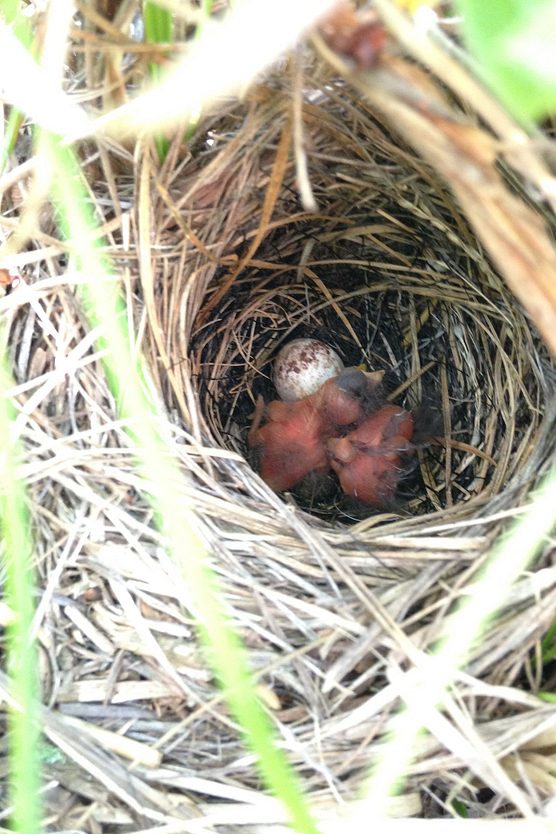 Researchers found that birds at the northern site produced young at a higher rate than in Adams County, perhaps because there are fewer parasitic cowbirds in the north.© JANET BREHM
Researchers found that birds at the northern site produced young at a higher rate than in Adams County, perhaps because there are fewer parasitic cowbirds in the north.© JANET BREHMThe birds at the northern site produced young at a much higher rate than in Adams County, possibly because the northern sites have better ground cover and fewer cowbirds, Anich says. Cowbirds lay their eggs in the nests of unsuspecting warblers, and the warblers incubate the eggs to the detriment of their own young, which hatch later and thus are smaller and have less food and less chance to survive than the cowbirds.
Kirtland's warblers and their progeny may benefit genetically from responding to the siren call of a recorded warbler. The immigrants may be coming from different populations and their mixing can help increase the genetic diversity of the Wisconsin population and contribute to its long-term survival.
Based on these factors and the amount of suitably aged jack pine in Wisconsin, Anich and Ward project that Wisconsin could someday support a population of 249 pairs of Kirtland's warblers.
Bocetti, the longtime leader of the national Kirtland's Warbler Recovery Team, is excited about these prospects, the playback results and Wisconsin's role in the recovery going forward. The U.S. Fish and Wildlife Service has recommended removing Kirtland's from the federal endangered species list thanks to its strong comeback in Lower Michigan, a reduction in threats and measures in place for the bird's long-term survival.
"We think Wisconsin is going to be very important to the vision of what recovery looks like," she says.
The breeding sites in northern Wisconsin and in Ontario and Upper Michigan are insurance against the bird's demise should some major catastrophes like wildfire or disease decimate the Lower Michigan population. These peripheral sites will become even more important for several reasons, Bocetti says. The changing climate may affect jack pine structure and insect availability in the core Michigan area and in Adams County and having the birds on public instead of private land in Wisconsin increases the chance the land will be managed to provide the jack pine habitat they need.
"The playback adds another tool in our toolbox to move forward in getting the Kirtland's warbler off the endangered species list," she says.
Anich and Ward say their findings can be used to expand the range of other bird species, with the greatest benefits likely for migratory species that are fairly rare and restricted in their distribution.
"This is not a silver bullet that will work with all species," Ward says. "But if it doesn't work it doesn't hurt anything. And if it works it can be a valuable conservation tool biologists can use to create new populations when species may have little success and we know we can do management in an area to make suitable habitat."
Lisa Gaumnitz is a natural resources educator and program and policy analyst for the DNR.
DECADE OF WORK PAYS OFF
Ten years after Kirtland's warblers were first documented in Wisconsin, populations of the endangered songbird have increased and their range is expanding through the efforts of state, federal and local partners.
Fifty-three birds and 20 total nests were documented in 2017, up from 11 birds and three nests in 2007, and the bird's breeding range has expanded from Adams County to include Marinette and Bayfield counties as well. Also, the birds fledged a minimum of 49 and up to 63 chicks in 2017.
"We're very encouraged by results of recent years and look forward to contributing more birds to the overall population in coming years," says Kim Grveles, a conservation biologist for DNR's Natural Heritage Conservation Program and longtime Wisconsin project leader.
Until 1995, Kirtland's warblers were found almost exclusively in the northern Lower Peninsula of Michigan and were struggling to recover from a steep decline in populations in the 1960s and 1970s due to habitat loss and nest parasitism by brown-headed cowbirds. Habitat management, monitoring and nest protection have helped lift Kirtland's warblers well above the recovery goal in Michigan and expand their range into Wisconsin, Upper Michigan and Ontario. Overall, population has increased from fewer than 200 breeding pairs in the 1970s to more than 2,300 breeding pairs today, more than doubling the recovery goal.
Wisconsin partners include the DNR; U.S. Fish and Wildlife Service; the University of Wisconsin; Natural Resources Foundation of Wisconsin; USDA Wildlife Services; Sand Valley Restoration Fund LLC; Meteor Timber; the Wisconsin Trapshooting Association; forest departments of Bayfield, Marinette, Vilas and Jackson counties; and many birders and other residents. Partners have made long-term commitments to managing thousands of acres in Bayfield and Adams counties for Kirtland's warbler by participating in the DNR Forest Legacy program.
Because of similar partnerships and their success in Lower Michigan, the U.S. Fish and Wildlife Service in April proposed removing the Kirtland's warbler from the federal endangered species list. The service is accepting public comments on the proposed delisting through July 11. A final decision will be made by next April.
Kirtland's warbler numbers in Wisconsin don't yet meet the criteria to be removed from the state's endangered species list. However, Wisconsin continues to be active in conservation efforts for the species, which began when it was first documented breeding here 10 years ago, and the state will continue work to increase the population.
If the bird is removed from the federal list, it will become the first "conservation reliant" animal to be removed from the endangered species list, says Carol Bocetti, longtime Kirtland's Warbler Recovery Team leader.
The species will always need management because its required habitat – young jack pine with open areas – depends on practices such as prescribed fire and timber harvest.
"We think we can take it all the way off the endangered species list because we have these partnerships and the tools in place," Bocetti says.
Drew Feldkirchner, who directs DNR's Natural Heritage Conservation Program, calls the proposed federal delisting "a huge milestone" for the overall recovery of the bird.
"Decades of commitment and hard work through public and private partnerships in Michigan have paid off," he says. "And we are also proud of the work our Wisconsin partners have done to increase our small but growing population.
– Lisa Gaumnitz

